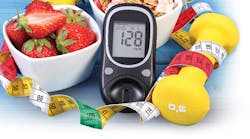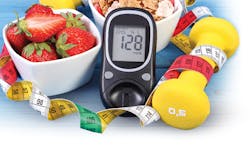Making each appointment specifically tailored to patients can provide motivation for the first step onto the path to a healthier life.
By Katie Melko, RDH, MSDH
During a diabetic patient’s dental visit, I make sure to carve out enough time to perform oral hygiene, offer nutrition education, as well as ask and answer questions regarding the patient’s home care and any symptoms the patient is experiencing such as dry mouth, sores, and pain. I like to do this before I begin the prophylaxis, while I’m cleaning the patient’s teeth, and after I finish to make sure I cover all that applies to my patient’s specific health needs.
Most of my patients aren’t aware of the resources available to help make their conditions more manageable and less uncomfortable. They just think that this is how it is ... that dry mouth is just something they will have to live with for the rest of their lives ... that sores and thrush are issues that will come and go, and they will just have to put up with them. They really don’t understand that getting their sugar levels under control and making healthier food choices can help significantly and even reduce the amount of medication they have to take daily.
For patients with diabetes, I recommend integrated care (foot, eye, and A1C testing from medical), recommend three- or four-month recall, Cavitron with Peridex, recommend dry mouth supplements if applicable, actively look for thrush, and discuss periodontal disease.
Here are my top five must-haves:
• Cavitron/hand scale
• Prerinse with dry mouth rinse
• Postrinse with Peridex
• Fluoride varnish
• Oral health instruction/nutrition education
I start with a dry mouth prerinse and then use the Cavitron, followed by hand scaling. I like to use the Cavitron to give the gingiva a lavage treatment and help remove heavy deposits. Then I hand scale to remove the rest of the bacteria, plaque, and hard deposits left on the teeth. Next, I floss, polish, and follow up with a postrinse of Peridex. If my patient has many areas of cervical decay and/or areas of sensitivity due to recession and abfraction, I will recommend and apply fluoride varnish to help remineralize the area and strengthen the enamel ... and also to help desensitize exposed root surfaces.
Depending on how periodontally involved my patient is, I will recommend PerioChip or Arestin to help with periodontal pocketing and their delayed healing due to diabetes. I like to combine this with scaling and root planing (SRP)—and separately if needed—for one or two areas that aren’t improving. PerioChip is a small, biodegradable chip that is inserted directly into the periodontal pocket and slowly dissolves. “PerioChip is an effective nonantibiotic adjunct treatment to scaling and root planing to reduce pocket depth in patients with adult periodontitis.”1 “Arestin is a locally applied antibiotic that is placed directly into the infected periodontal pocket at the time of scaling and root planing (SRP). Arestin has a unique delivery system where minocycline microspheres are administered as a powder to allow for easy, targeted placement at the base of the periodontal pocket.”2
Recare
I generally recommend three cleanings a year, every four months, unless the patient is more involved and needs more care or just completed SRP. Then I will do three-month recalls until the patient has stabilized, moving to four-month prophies. It is very patient specific, too, depending on medical history, home-care habits, and treatment compliance.
There are those patients who refuse to hear anything I say, don’t want to floss, don’t care about their oral hygiene, and visit only once a year. These are the patients who eventually fall victim to the ongoing effects of periodontal disease and eventually end up losing teeth. It’s very sad to see this, but there is only so much you can do as a provider and educator. I try to change my approach the next time I see the patient in an effort to present oral care options in such a way that the patient will be open to communicating with me, but it is rare that these patients change. All you can do is your best, and you can only worry about how you handle yourself in situations such as these.
Most of my patients aren’t aware of the resources available to help make their conditions more manageable and less uncomfortable. They just think that this is how it is ...
Home care
I recommend Waterpik and floss. Many patients claim they just can’t floss. I explain that it takes a while to get used to it, but if they can create the habit, it will just become something they do every day. If patients just won’t floss, I recommend floss picks and proxy brushes for interdental cleaning. Some of my favorite over-the-counter dry mouth products are Oasis, Biotene, and Act Dry Mouth. For patients who don’t suffer from dry mouth, these rinses top my list: Colgate Peroxyl, Peridex, Closys, or any nonalcohol-based mouthwash.
Most of the patients I treat are on limited incomes, so I like to offer a range of options in hopes they can afford something to help them. If a patient can’t afford anything extra, I recommend warm salt water rinses and brushing with baking soda and water. At least the baking soda will control the pH in their saliva and help reduce bacteria, and the salt water rinse will help soothe and heal the tissues.
Nutrition
I find that nutrition is an important topic when discussing diabetes with patients. Some foods that patients think are really healthy are actually full of sugars and work against them. I usually like to share some foods to avoid and some great alternatives.
• Foods to avoid: white bread, pasta, rice, fruit-flavored yogurts, flavored coffee drinks, and sugary drinks
• Good food options:apples, oatmeal, green vegetables, nuts, and beans
Patients are often surprised when I share these lists, because they aren’t always aware of the effects that the foods they eat have on their health.
Each time you see patients for recall visits, ask how things you recommended worked out and see if they tried them or didn’t like them, etc. This will give you an idea of what is or isn’t working, and it also presents an opportunity to recommend something else. There are so many great products on the market geared toward helping patients with specific issues. Sometimes it just takes trying a few before you find the best fit for the patient.
With diabetic patients, a tailored appointment will help get you in the mind-set of what to look out for and how to start the conversation to get the patient on a healthier path. In my workplace, we offer integrated health, which works well to ensure that diabetic patients are getting eye, foot, and regular A1C checks. I can see the medications the patients are taking, as well as the medical conditions they have. This helps me prepare for my appointments with them. It’s important to listen to our patients to get an idea of how they think and process information so that we can deliver oral health education and nutrition in the best way for them to understand it.
Every day I strive to make the connection between the mouth and the rest of the body in hopes that patients will understand that taking care of their oral health benefits their overall health. Keep moving forward and making an impact on your patients’ lives, and you will see a difference. There is no better feeling than when you see a night-and-day change from your patient’s last visit and he says, “You’ll be so proud ...” and pulls floss out of a pocket. Go out there, tailor your appointments to your patients, and let me know if it makes a difference in your day!
Katie Melko, RDH, MSDH, is a public health hygienist at Community Health Center Inc. She graduated from Fones School of Dental Hygiene at the University of Bridgeport in 2016 with an MSDH. She has practiced dental hygiene since 2009.
References
1. PerioChip. PerioChip website. Drexcel Pharma Technologies Ltd. http://us.periochip.com/. Accessed February 25, 2018.
2. Arestin. OraPharma website. Valeant Pharmaceuticals North America LLC. http://www.arestinprofessional.com/administration. Accessed February 25, 2018.







